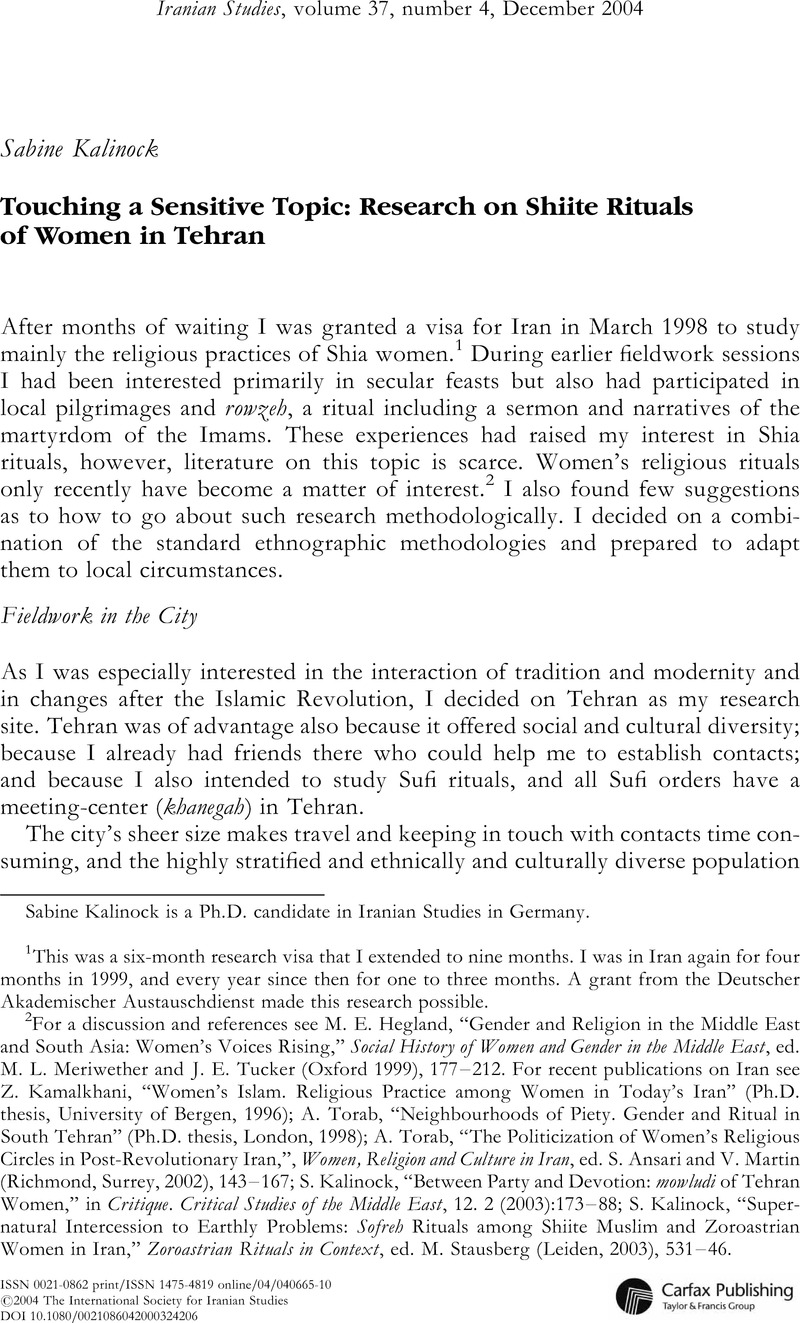Article contents
Touching a Sensitive Topic: Research on Shiite Rituals of Women in Tehran
Published online by Cambridge University Press: 01 January 2022
Abstract

- Type
- Articles
- Information
- Iranian Studies , Volume 37 , Issue 4: Special Issue: Ethnographic Fieldwork in Iran , December 2004 , pp. 665 - 674
- Copyright
- Copyright © 2004 The International Society for Iranian Studies
References
1 This was a six-month research visa that I extended to nine months. I was in Iran again for four months in 1999, and every year since then for one to three months. A grant from the Deutscher Akademischer Austauschdienst made this research possible.
2 For a discussion and references see Hegland, M. E., “Gender and Religion in the Middle East and South Asia: Women's Voices Rising,” Social History of Women and Gender in the Middle East, ed. Meriwether, M. L. and Tucker, J. E. (Oxford 1999), 177–212Google Scholar. For recent publications on Iran see Kamalkhani, Z., “Women's Islam. Religious Practice among Women in Today's Iran” (Ph.D. thesis, University of Bergen, 1996)Google Scholar; Torab, A., “Neighbourhoods of Piety. Gender and Ritual in South Tehran” (Ph.D. thesis, London, 1998)Google Scholar; Torab, A., “The Politicization of Women's Religious Circles in Post-Revolutionary Iran,”, Women, Religion and Culture in Iran, ed. Ansari, S. and Martin, V. (Richmond, Surrey, 2002), 143–167Google Scholar; Kalinock, S., “Between Party and Devotion: mowludi of Tehran Women,” in Critique. Critical Studies of the Middle East, 12. 2 (2003): 173–88CrossRefGoogle Scholar; Kalinock, S., “Supernatural Intercession to Earthly Problems: Sofreh Rituals among Shiite Muslim and Zoroastrian Women in Iran,” Zoroastrian Rituals in Context, ed. Stausberg, M. (Leiden, 2003), 531–46Google Scholar.
3 See Marcus, G., Ethnography through Thick and Thin, (Princeton, 1998)Google Scholar and his remarks on a multi-sided ethnography.
4 Most women's rituals are led by a “khanom-e jalaseh” (mistress of the gathering), others are conducted by a male cleric often of low rank. I established the more intensive and regular contacts with female religious leaders.
5 Compare Marcus, Ethnography, 121–123.
6 A religious gathering on the birthdays of members of the Prophet's family and on other feast days, which includes the singing of special poems, and sometimes drumming on the daff (frame drum) and dancing.
7 My “self” was fragmented: in the morning I would listen completely veiled to a preacher's condemnation of dangerous rituals where improperly dressed women engaged in illicit activities like dancing and singing, and in the afternoon I would participate in exactly these ceremonies. For a similar experience see Gardner, Katy, “Location and Relocation: Home, ‘the Field’ and Anthropological Ethics (Sylhet, Bangladesh),” Being There: Fieldwork in Anthropology, ed. Watson, C. W. (London, 1999)Google Scholar.
8 On the influence of the researcher, see Devereux, G., From Anxiety to Method in the Behavioral Sciences (The Hague, 1967)CrossRefGoogle Scholar.
9 Simmel, G., The Sociology of Georg Simmel, transl. and ed. Wolff, Kurt H. (New York, 1964)Google Scholar.
10 Sofreh-ye Bibi Seh Shanbeh, The Lady of Tuesday, is dedicated to a holy woman of unclear origin; jashn-e Omar koshan celebrates the death of the second caliph.
11 Persian polite manners (ta'ruf) prevented women from giving me a straightforward “no” at such occasions; instead, the women kept postponing dates or referring me to authorities. I spent many days at home waiting for telephone calls that never came.
12 I am aware of the limitations of such honesty. Especially in large gatherings not everybody may be fully aware of the research intention. See Burgess, R.G., “Some Role Problems in Field Research,” Field Research: A Sourcebook and Field Manual, ed. Burgess, R. G. (London and New York, 1994): 45–49Google Scholar.
13 Starrett, G., “The Anthropology of Islam,” Anthropology of Religion: A Handbook, ed. Glazier, S. D. (London, 1997): 279–30Google Scholar.
14 12 coins for the Twelve Imams, five rial for the panj tan— “the five bodies”: the Prophet Mohammad, his daughter Fatima, Imam Ali, Hasan, and Husein.
15 For a further discussion of the politicization of women's religious circles in Iran, see Torab, Neighborhoods.
- 3
- Cited by


